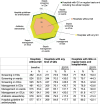Status of Sepsis Care in European Hospitals: Results from an International Cross-Sectional Survey
- PMID: 39787606
- PMCID: PMC12005017
- DOI: 10.1164/rccm.202406-1167OC
Status of Sepsis Care in European Hospitals: Results from an International Cross-Sectional Survey
Abstract
Rationale: Early detection, standardized therapy, adequate infrastructure, and strategies for quality improvement should constitute essential components of every hospital's sepsis plan. Objectives: To investigate the extent to which recommendations from the sepsis guidelines are implemented and the availability of infrastructure for the care of patients with sepsis in acute-care hospitals. Methods: A multidisciplinary cross-sectional questionnaire was used to investigate sepsis care in hospitals. This included the use of sepsis definitions, the implementation of sepsis guideline recommendations, diagnostic and therapeutic infrastructure, antibiotic stewardship, and quality improvement initiatives (QIIs) in hospitals. Measurements and Main Results: A total of 1,023 hospitals in 69 countries were included. Most of them, 835 (81.6%), were in Europe. Sepsis screening was used in 54.2% of emergency departments (EDs), 47.9% of wards, and 61.7% of ICUs. Sepsis management was standardized in 57.3% of EDs, 45.2% of wards, and 70.7% of ICUs. The implementation of comprehensive QIIs was associated with increased screening (EDs, +33.3%; wards, +44.4%; ICUs, +23.8% absolute difference) and increased standardized sepsis management (EDs, +33.6%; wards, +40.0%; ICUs, +17.7% absolute difference) compared with hospitals without QIIs. A total of 9.8% of hospitals had implemented ongoing QIIs, and 4.6% had invested in sepsis programs. Conclusions: The findings indicate that there is considerable room for improvement in a large number of mainly European hospitals, particularly with regard to early identification and standardized management of sepsis, the availability of guidelines, diagnostic and therapeutic infrastructure, and the implementation of QIIs. Further efforts are required to implement a more comprehensive and appropriate quality of care.
Keywords: quality of care; sepsis management; sepsis programs; sepsis screening; standard of care.
Figures





Comment in
-
What Can We Learn from Differences in Hospitals' Sepsis Care?Am J Respir Crit Care Med. 2025 Apr;211(4):546-547. doi: 10.1164/rccm.202501-0106ED. Am J Respir Crit Care Med. 2025. PMID: 40019819 Free PMC article. No abstract available.
References
-
- World Health Organization. Geneva, Switzerland: WHO; 2017. WHA 70.7 resolution: improving the prevention, diagnosis and clinical management of sepsis.https://apps.who.int/gb/ebwha/pdf_files/WHA70/A70_R7-en.pdf
-
- G7 Health Ministers. Communique: G7 Health Ministers. 2022. https://www.g7germany.de/resource/blob/974430/2042058/5651daa321517b089c...
-
- Scheer CS.The need for a European sepsis registry; 19th Congress of the European Shock Society. ;
MeSH terms
Grants and funding
LinkOut - more resources
Full Text Sources
Medical

